Papilledema indicates - Study guides, Class notes & Summaries
Looking for the best study guides, study notes and summaries about Papilledema indicates? On this page you'll find 796 study documents about Papilledema indicates.
Page 2 out of 796 results
Sort by
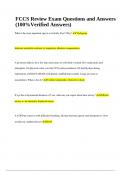
-
FCCS Review Exam Questions and Answers (100%Verified Answers).
- Exam (elaborations) • 15 pages • 2024
- Available in package deal
-
- $11.99
- + learn more
FCCS Review Exam Questions and Answers (100%Verified Answers). What is the most important sign in a critically ill pt? Why? Tachypnea Indicates metabolic acidosis w/ respiratory alkalosis compensation A pt misses dialysis for a few days and comes in with fluid overload. He's tachycardic and tachypneic. On physical exam, you find JVD, pulsus paradoxus (20 mmHg drop during inspiration), and HoTN (80/40) with distant, muffled heart sounds. Lungs are clear to auscultation. What is the dx? Car...
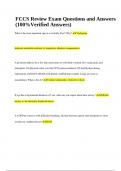
-
FCCS Review Exam Questions and Answers (100%Verified Answers).
- Exam (elaborations) • 15 pages • 2024
- Available in package deal
-
- $11.99
- + learn more
FCCS Review Exam Questions and Answers (100%Verified Answers). What is the most important sign in a critically ill pt? Why? Tachypnea Indicates metabolic acidosis w/ respiratory alkalosis compensation A pt misses dialysis for a few days and comes in with fluid overload. He's tachycardic and tachypneic. On physical exam, you find JVD, pulsus paradoxus (20 mmHg drop during inspiration), and HoTN (80/40) with distant, muffled heart sounds. Lungs are clear to auscultation. What is the dx? Car...
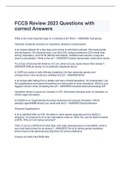
-
FCCS Review 2023 Questions with correct Answers
- Exam (elaborations) • 7 pages • 2023
- Available in package deal
-
- $9.99
- 6x sold
- + learn more
What is the most important sign in a critically ill pt? Why? - ANSWER-Tachypnea Indicates metabolic acidosis w/ respiratory alkalosis compensation A pt misses dialysis for a few days and comes in with fluid overload. He's tachycardic and tachypneic. On physical exam, you find JVD, pulsus paradoxus (20 mmHg drop during inspiration), and HoTN (80/40) with distant, muffled heart sounds. Lungs are clear to auscultation. What is the dx? - ANSWER-Cardiac tamponade; obstructive shock If a pt ...

-
HESI EXIT EXAM TEST BANK 2024/2025
- Exam (elaborations) • 179 pages • 2024
-
- $29.99
- 1x sold
- + learn more
HESI EXIT EXAM TEST BANK 2024/2025 HESI EXIT EXAM TEST BANK 2024/2025 1. An adolescent with major depressive disorder has been taking duloxetine (Cymbalta) for the past 12 days. Which assessment finding requires immediate follow-up? 2. A 60-year-old female client with a positive family history of ovarian cancer has developed an abdominal mass and is being evaluated for possible ovarian cancer. Her Papanicolau (Pap) smear results are negative. What information should the nurse ...

-
FCCS Review 2024 Questions with correct Answers| Already Passed
- Exam (elaborations) • 13 pages • 2023
-
- $10.49
- + learn more
What is the most important sign in a critically ill pt? Why? - Tachypnea Indicates metabolic acidosis w/ respiratory alkalosis compensation A pt misses dialysis for a few days and comes in with fluid overload. He's tachycardic and tachypneic. On physical exam, you find JVD, pulsus paradoxus (20 mmHg drop during inspiration), and HoTN (80/40) with distant, muffled heart sounds. Lungs are clear to auscultation. What is the dx? - Cardiac tamponade; obstructive shock If a pt has a thyromenta...
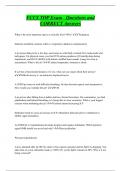
-
FCCS TOP Exam Questions and CORRECT Answers
- Exam (elaborations) • 47 pages • 2024
-
- $8.99
- + learn more
What is the most important sign in a critically ill pt? Why? Tachypnea Indicates metabolic acidosis (often w/ respiratory alkalosis compensation) A pt misses dialysis for a few days and comes in with fluid overload. He's tachycardic and tachypneic. On physical exam, you find JVD, pulsus paradoxus (20 mmHg drop during inspiration), and HoTN (80/40) with distant, muffled heart sounds. Lungs are clear to auscultation. What is the dx? Cardiac tamponade; obstructive shock If a pt has a thyr...
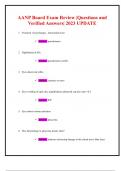
-
AANP Board Exam Review |Questions and Verified Answers| 2023 UPDATE
- Exam (elaborations) • 21 pages • 2023
- Available in package deal
-
- $10.49
- + learn more
AANP Board Exam Review |Questions and Verified Answers| 2023 UPDATE 1. Transient visual changes , intracranial noise Answer: psuedotumor 2. Papilledema & HA Answer: psuedotumor cerebri 3. Eyes absent red reflex Answer: cataracts or mass 4. Eyes swelling of optic disc (papilledema) abnormal cup disc ratio >0.5 Answer: ICP 5. Eyes absent venous pulsation Answer: gluacoma 6. Disc hemorrhage in gluacoma means what?...
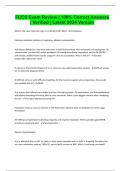
-
FCCS Exam Review | 100% Correct Answers | Verified | Latest 2024 Version
- Exam (elaborations) • 9 pages • 2024
- Available in package deal
-
- $8.49
- + learn more
What is the most important sign in a critically ill pt? Why? - Tachypnea Indicates metabolic acidosis w/ respiratory alkalosis compensation A pt misses dialysis for a few days and comes in with fluid overload. He's tachycardic and tachypneic. On physical exam, you find JVD, pulsus paradoxus (20 mmHg drop during inspiration), and HoTN (80/40) with distant, muffled heart sounds. Lungs are clear to auscultation. What is the dx? - Cardiac tamponade; obstructive shock If a pt has a thyromental...

-
FCCS Review exam 2024 with 100% correct answers
- Exam (elaborations) • 9 pages • 2024
-
- $16.49
- + learn more
What is the most important sign in a critically ill pt? Why? - correct answer Tachypnea Indicates metabolic acidosis w/ respiratory alkalosis compensation A pt misses dialysis for a few days and comes in with fluid overload. He's tachycardic and tachypneic. On physical exam, you find JVD, pulsus paradoxus (20 mmHg drop during inspiration), and HoTN (80/40) with distant, muffled heart sounds. Lungs are clear to auscultation. What is the dx? - correct answer Cardiac tamponade; obstructive s...

-
BIO 669 Exam 1 Practice Questions and Complete Solutions
- Exam (elaborations) • 6 pages • 2024
- Available in package deal
-
- $8.99
- + learn more
papilledema indicates increased intercranial pressure hypocalcemia will result in which of the following signs and symptoms neuromuscular excitability and spasms, intestinal cramping, and tingling where is most of the Na+ in our bodies found extracellular fluid Colloid osmotic pressure is pressure created by only the protein in fluid Thre effect of hypocalcemia on neuromuscular system is increased neuromuscular excitability the law of mass action dictates that if CO2 levels in the tissue or...

Did you know that on average a seller on Stuvia earns $82 per month selling study resources? Hmm, hint, hint. Discover all about earning on Stuvia


